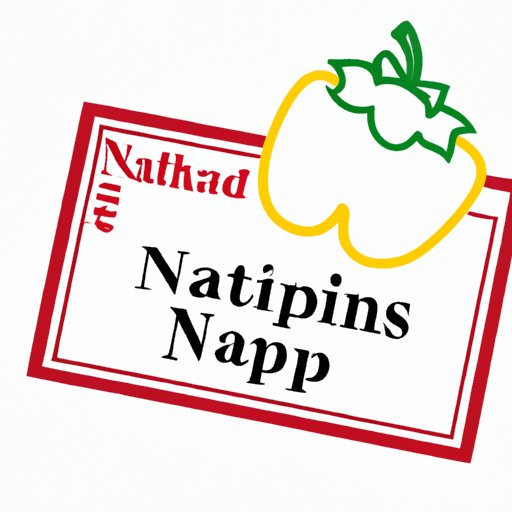
I. Introduction
Accessing nutritious food can be a challenge for many individuals and families, especially those who rely on food stamps to make ends meet. Despite the misconception that food stamps can only be used to buy junk food or unhealthy snacks, there are actually plenty of options for purchasing fresh fruits and vegetables, dairy products, meats, and bread. This article aims to provide a guide to using food stamps to access healthy and affordable food, as well as resources and programs available to support those who rely on this benefit.
II. What You Can Buy With Food Stamps
There are many options for purchasing nutritious food with food stamps. Fresh fruits and vegetables, dairy products, meats, and bread are all eligible items. It is important to remember that prepared foods, like hot deli items or restaurant meals, are not usually eligible. In some states, plant-based milk alternatives like almond milk or soy milk are covered, but it is important to check with your local SNAP office to confirm what is eligible in your area.
When shopping at the grocery store, eligible items will have a blue EBT logo on the price tag. This indicates that the item can be purchased with food stamps. Be sure to check the label on each item before adding it to your cart, as some items may have certain flavors or varieties that are not eligible.
III. Farmers Markets and Food Stamps
Using food stamp benefits at farmers markets is a great way to access fresh, local produce and support the livelihoods of small farmers in your community. Many farmers markets now accept SNAP benefits and some even offer bonus programs that allow you to double your benefits when purchasing fresh produce. These programs may be known as Double Up Food Bucks or Fresh Bucks, depending on your area.
Shopping at farmers markets also has the added benefit of reducing your carbon footprint. When you buy locally, you are supporting sustainable agriculture practices and reducing the amount of transportation needed to get the food to your plate.
IV. Recipes and Meal Ideas
Cooking at home is often a more affordable and nutritious option than eating out or buying pre-packaged meals. However, many people feel intimidated by cooking or are unsure what to make with the ingredients they have on hand. To help, we’ve included some easy recipes and meal ideas that can be made with ingredients that can be purchased with food stamps.
For example, a simple vegetable stir fry can be made with frozen vegetables, brown rice, and soy sauce. Bean-based soups and stews are also affordable and nutritious options. Overnight oats, made with rolled oats, plant-based milk and fresh fruit, are a great breakfast option that can be customized to your liking. For more recipe ideas, check out online resources like budgetbytes.com or download the SNAP cookbook from the USDA.
V. Eligibility and Requirements
To be eligible for food stamps, you must meet certain income limits and citizenship or residency requirements. The income limit varies depending on household size and there are also asset limits to consider. To determine if you are eligible, you can visit the USDA website or contact your local SNAP office to apply. It is important to provide all necessary documentation when applying, including proof of income and residency.
It is also important to note that food stamps are intended to be a supplement to your food budget, not the sole source of your grocery funds. It is recommended that you budget your benefits carefully to ensure they last throughout the month and prioritize purchasing nutritious foods.
VI. Supplemental Nutrition Assistance Program (SNAP)
The Supplemental Nutrition Assistance Program (SNAP) is a federal program that helps individuals and families who are food insecure access nutritious and affordable food. In addition to providing food stamp benefits, SNAP also funds nutrition education programs and community outreach initiatives.
Studies show that SNAP benefits have a positive impact on food security and health outcomes for those who utilize the program. For example, children who receive SNAP benefits are more likely to be in good health and graduate from high school, while elderly adults who receive SNAP benefits are less likely to be admitted to a hospital or nursing home.
VII. Checking Your Food Stamp Balance
It’s important to keep track of your food stamp balance and budget accordingly. You can check your balance and account information online or through a mobile app, depending on your state’s system. Be sure to check your balance regularly to avoid overspending or running out of benefits before the end of the month.
VIII. Community Resources and Programs
There are many community resources and programs available to support individuals who utilize food stamps. Nutrition education classes, cooking demonstrations, and food pantries are just a few examples. Some organizations may also offer job training or financial literacy classes to help individuals become more self-sufficient. Be sure to check with your local SNAP office or food bank to see what resources are available near you.
IX. Conclusion
Accessing nutritious and affordable food is a right that everyone deserves. While utilizing food stamps can be challenging, there are many resources and programs available to support individuals and families who rely on this benefit. By shopping at farmers markets, cooking at home, and seeking out community resources, you can make the most of your food stamp benefits and lead a healthy, fulfilling life. Remember, you are not alone and there is no shame in asking for help when you need it.





